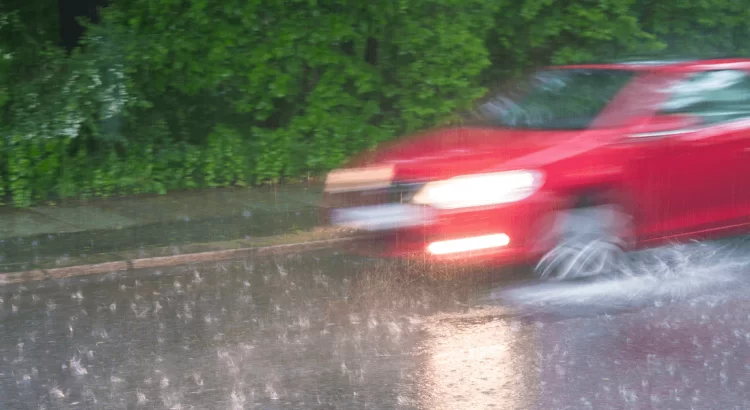
Aquaplaning: What it is and How to stay safe
During the first rains, drivers risk losing control of their vehicle due to aquaplaning, resulting in road accidents.
Whether you’re an experienced driver or new on the road, understanding the dangers of aquaplaning and knowing how to deal with it is essential to staying safe.
Keep reading to find out why it happens, spot the warning signs and, most importantly, discover how to avoid aquaplaning.
![]()
- Automatic Transmission: How It Works
What is Aquaplaning?
Also known as hydroplaning, aquaplaning is a dangerous phenomenon that occurs when a vehicle loses contact with the road surface due to water on the road.
Aquaplaning happens when a layer of water builds up between a car’s tyres and the asphalt, reducing the tyre grip on the road surface.
As a result, drivers lose control of their vehicles, which skid uncontrollably.
When may a Car Aquaplane?
Aquaplaning can happen in specific wet road conditions or heavy rain when a layer of water builds up between a vehicle’s tyres and the road surface.
However, other situations may lead to aquaplaning, such as incorrect tyre pressure, worn tyres, speeding, or the depth of water on the road.
What are the Tell-tale Signs of Aquaplaning?
The most common signs of this phenomenon include:
- Feeling as if your car is floating;
- Speed reducing without braking;
- Steering wheel vibrating (may be a sign that the tyres have lost their grip);
- Difficulty turning as the tyres do not respond properly;
- Loss of control of the vehicle, losing normal response to steering wheel commands, such as power steering.
Which Factors Make Aquaplaning Worse?
When driving in heavy rain or on wet roads, speed is a critical element that can significantly increase the risk of aquaplaning.
As such, speeding can be considered one of the main factors that aggravate hydroplaning.
What Should you do if you find you are Aquaplaning?
In the event of aquaplaning, it is crucial you take immediate action to regain control of your vehicle to avoid accidents. As such, make sure you:
- Avoid sudden movements;
- Release the accelerator pedal gradually;
- Reduce your speed as your vehicle regains grip on the road surface;
- Firmly hold the steering wheel with both hands to maintain control of your vehicle;
- Avoid braking sharply, as braking may cause your wheels to lock and your vehicle to skid further.

What Should You Do to Prevent Hydroplaning?
Replacing your tyres when worn to improve grip and changing your windscreen wiper blades to allow for good visibility are two preventive measures all drivers must take.
Last but not least, you should adopt defensive driving and reduce your speed, which is also essential when driving in adverse conditions.
How Important are Tyres to Preventing Aquaplaning?
Tyres are key in preventing hydroplaning, especially in heavy rain or wet conditions.
This importance relates to several crucial factors:
Tyre Tread
Composed of the rubber that comes into contact with the road surface and the groove pattern carved into it, the tyre tread allows water to be expelled from between the tyres and the road surface.
This ensures that a car’s tyres maintain a good grip.
Depth of Tread
The depth of the tyre tread is another determining factor, as the greater the depth, the greater a tyre’s water drainage capacity.
As tyres wear out, the tread depth decreases, compromising a tyre’s ability to handle water on the road.
Tyre Pressure
Tyres with inadequate pressure can negatively affect the grip on the tread.
While tyres with a pressure below what is recommended have a larger contact area with the road, tyres with a pressure that is too high may have a smaller contact area.

Want some Tips for Driving in the Rain?
Driving in the rain requires special precautions to ensure road safety.
As such, you should take these measures to ensure safe driving in adverse conditions:
1. Maintain Safety Distances
It is advisable to keep a safe distance from the vehicle in front of you. However, if it’s raining, this is all the more important, and a distance should be kept that allows you to see whether the car in front of you is braking.
2. Avoid Emergency Braking
As well as keeping safety distances and driving at speeds well below the limit, drivers should avoid braking suddenly.
3. Not Allowing your Windows to Mist
Good visibility is vital in rainy conditions, so demisting your windows is a must.
4. Turn on your Fog Lights
One of the key ideas taught at driving schools is “see and be seen”. As such, under these conditions, turning fog lights on so that you can see and be seen is particularly important.
5. Adjust your Speed
Even if you are driving below the speed limit, this may not be slow enough.
You must adapt your speed to the weather, and, in this particular case, you should drive slower than ever.
As you can see, aquaplaning may happen at any time if you are not careful. However, it is preventable if you take the proper precautions. Follow them and drive safely!
Interested in finding out more about the world of all-things cars? Then follow us on Facebook and keep up with our daily content.
![]()
